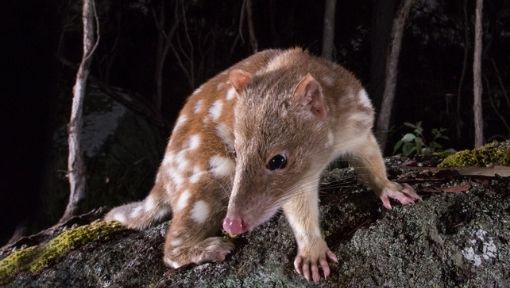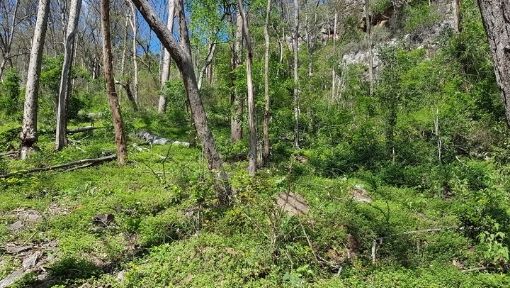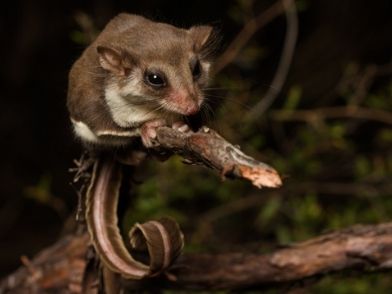Spotted-tailed quoll
© Michael J Barritt
The spotted-tailed quoll is mainland Australia’s largest marsupial carnivore. As an apex predator, it plays an important role in regulating populations of its prey. Two subspecies — Dasyurus maculatus gracilis and Dasyurus maculatus maculatus — differ subtly in body size, coat colour, patterning and genetics.
Quick facts
Spotted-tailed quoll
SCIENTIFIC NAME:
Dasyurus maculatus
Subspecies:
- Dasyurus maculatus gracilis (from the wet tropics of north-eastern Queensland)
- Dasyurus maculatus maculatus (from South East Queensland, New South Wales, Victoria and Tasmania)
FAMILY:
Dasyuridae
- D. maculatus maculatus: Endangered
- D. maculatus gracilis: Endangered
NATIONAL CONSERVATION STATUS:
- D. maculatus maculatus: Endangered
- D. maculatus gracilis: Endangered
How we help quolls
Since 2007, Wildlife Queensland’s dedicated Quoll Seekers Network has been actively surveying for spotted-tailed quolls in key locations across South East Queensland using baited remote cameras and scent detection dog surveys teams. Our survey data has been used to increase the quality and quantity of knowledge, and to raise much-needed community awareness about quolls in Queensland.
 © Bruce Thomson
© Bruce Thomson
Did you know?
The spotted-tailed quoll was one of the first Australian animals to be encountered by Europeans. Arthur Phillip’s party collected one at Port Jackson in 1788.
 © Wildlife Queensland
© Wildlife Queensland
Threats to the spotted-tailed quoll
- Habitat loss due to land clearing
- Being killed at poultry yards and accidental road deaths
- Poisoning by eating cane toads and 1080 baits laid for wild dogs
- Predation and competition by dogs, cats (eat quoll young) and foxes (minor threat contributing to an overall drop in populations).
- Predation by wedge-tailed eagles, dingoes, pythons, large forest owls and goannas
Home range
- Quolls are solitary with home ranges of up to 4000ha. Female home ranges are generally much smaller than this, although still several hundred hectares in size.
Distribution
Spotted-tailed quolls are found in:
- Tasmania and forested areas of South Australian–Victorian border to Cooktown in north Queensland.
- Queensland distribution is patchy along the east coast. Quoll hotspots are in the Border Ranges and the mountains and tablelands between Townsville and Cooktown.
Description
- Longer than 75cm nose to tail tip, therefore, larger by three or four times than any of the other five species of quoll.
- Hindfoot length greater than 55mm.
- The only quoll species in which spots continue from the body onto the tail.
Signs
- Scats left within its habitat:
- on prominent rock outcrops, creek beds and escarpment lines
- have a distinctive musky smell (not the sharp unpleasant smell of fresh cat, dog or fox scats)
- twisted ropey appearance
- often deposited in communal latrine sites, where dozens of scats can accumulate during a season.
- Repeated attacks upon caged poultry (often the first noticeable sign) in which:
- only the head or parts of the neck are consumed on the first night
- quolls return to these carcasses day after day until all is consumed.
- Tracks in soft ground.
Sounds
The low-pitch hiss and screech on this recording are both quoll calls.
Spotted-tailed quoll calls
Habitat
- Forest and woodland, including rainforest, and wet and dry sclerophyll forest and woodland.
- Within these habitats, rocky escarpments or boulder piles are favoured.
Ecology
Life history
Quolls live for less than 3-4 years. Females rarely breed after the age of 3 years. This probably explains their threatened status: populations die out if recruitment (i.e. new animals born or moving into the population) is low for as few as 2–3 successive years.
Breeding
- Quolls are solitary. However, both males and females mate with multiple partners during their brief autumn and winter breeding period.
- Spotted-tailed quolls have a single litter of up to 6 young each year, born between May and August.
- Each litter is sired by more than one father.
- Young are carried in a rudimentary pouch and, when they become too large, they are left behind in a nursery den while the mother forages.
- Young quolls become independent at about 100 days.
Food
- Opportunistic predators and scavengers of anything of animal origin.
- Hunt on the ground and in trees for rodents, bandicoots and possums — their main prey.
- Females and juveniles eat smaller prey than the larger males and include more reptiles and birds in their diet than males do.
- Prey or carrion can be too large to be eaten in one sitting, so quolls return daily until the meal is completely consumed (see Signs above).
More information
Publications & published papers
- Belcher, C.A. and Darrant, J.P. (2004) Home range and spatial organization of the marsupial carnivore, Dasyurus maculatus maculatus (Marsupialia: Dasyuridae) in south-eastern Australia. Journal of Zoology 262:3, 271-280
- Belcher, C.A. and Darrant, J.P. (2006) Habitat use by tiger quoll (Dasyurus maculatus) (Marsupialia: Dasyuridae) in south-eastern Australia. Journal of Zoology 269:2, 183-190
- Claridge, A.W., Murray, A.J., Dawson, J., Poore, R., Mifsud, G.& Saxon, M.J. (2006). The propensity of spotted-tailed quolls (Dasyurus maculatus) to encounter and consume non-toxic meat baits in a simulated canid-control program. Wildlife Research 33(2) 85-91
- Glen, A.S. & Dickman, C.R. (2006) Home range, denning behaviour and microhabitat use of the carnivorous marsupial Dasyurus maculatus in eastern Australia. Journal of Zoology 268:4, 347-354
- Murray, A.J. & Poore, R. M. (2004). Potential impact of aerial baiting for wild dogs on a population of spotted-tailed quolls (Dasyurus maculatus). Wildlife Research 31(6) 639-644
Websites
- Wildlife Queensland Quoll Seekers Network
- NSW Office of Environment and Heritage: quoll species profile
- Commonwealth Department of the Environment and Energy: quoll species profile
- Parks and Wildlife Service Tasmania: quoll species profile




